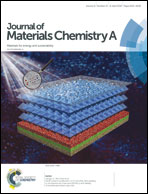ZnO as an effective hole transport layer for water resistant organic solar cells†
Abstract
Organic solar cells (OSCs) are a major contender for third generation photovoltaic systems. However, the scalability and potential commercial viability of OSCs are still limited due to their instability under hostile ambient conditions such as a humid atmosphere. One of the major limiting factors in this context is the water-solubility of the hole transport layer (HTL). As a solution to this problem, in the given work, we report the design of an ultrathin, water-resistant and p-type-like conducting ZnO film serving as a HTL for inverted OSCs. This film is fabricated using ultrasonic spray pyrolysis under ambient conditions and subsequently transferred onto the active layer of the OSC using a sacrificial poly(styrenesulfonate) (PPS) film. The resulting ZnO film has oxygen-rich and zinc-deficient characteristics which stem presumably from a gradient-like doping of PSS chelating with zinc species. These characteristics result in a suitable energy level realignment and facilitate p-type-like charge transport to the anode. The fabricated device has excellent stability and only minor loss in performance upon a prolonged immersion in water without encapsulation, in striking contrast to the commonly used MoOx HTL OSC which was completely deteriorated.



 Please wait while we load your content...
Please wait while we load your content...